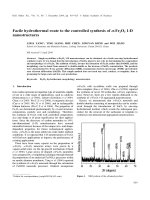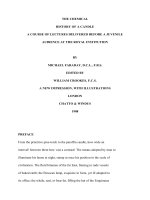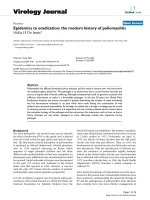The Chemical History Of A Candle, by Michael Faraday docx
Bạn đang xem bản rút gọn của tài liệu. Xem và tải ngay bản đầy đủ của tài liệu tại đây (677.04 KB, 346 trang )
Project Gutenberg's The Chemical History
Of A Candle, by Michael Faraday
This eBook is for the use of anyone
anywhere at no cost and with almost no
restrictions whatsoever. You may copy it,
give it away or re-use it under the terms of
the Project Gutenberg License included
with this eBook or online at
www.gutenberg.net
Title: The Chemical History Of A Candle
Author: Michael Faraday
Release Date: December 26, 2004
[EBook #14474] [Date last updated:
October 1, 2005]
Language: English
*** START OF THIS PROJECT
GUTENBERG EBOOK THE
CHEMICAL HISTORY OF A CANDLE
***
Produced by Clare Boothby, Richard
Prairie and the PG Online Distributed
Proofreading Team
THE CHEMICAL
HISTORY OF A
CANDLE
A COURSE OF LECTURES DELIVERED
BEFORE A JUVENILE AUDIENCE AT THE
ROYAL INSTITUTION
BY
MICHAEL FARADAY, D.C.L., F.R.S.
EDITED BY
WILLIAM CROOKES, F.C.S.
A NEW IMPRESSION, WITH
ILLUSTRATIONS
LONDON
CHATTO & WINDUS
1908
PREFACE
From the primitive pine-torch to the
paraffin candle, how wide an interval!
between them how vast a contrast! The
means adopted by man to illuminate his
home at night, stamp at once his position
in the scale of civilisation. The fluid
bitumen of the far East, blazing in rude
vessels of baked earth; the Etruscan lamp,
exquisite in form, yet ill adapted to its
office; the whale, seal, or bear fat, filling
the hut of the Esquimaux or Lap with
odour rather than light; the huge wax
candle on the glittering altar, the range of
gas lamps in our streets,—all have their
stories to tell. All, if they could speak
(and, after their own manner, they can),
might warm our hearts in telling, how they
have ministered to man's comfort, love of
home, toil, and devotion.
Surely, among the millions of fire-
worshippers and fire-users who have
passed away in earlier ages, some have
pondered over the mystery of fire; perhaps
some clear minds have guessed shrewdly
near the truth. Think of the time man has
lived in hopeless ignorance: think that
only during a period which might be
spanned by the life of one man, has the
truth been known.
Atom by atom, link by link, has the
reasoning chain been forged. Some links,
too quickly and too slightly made, have
given way, and been replaced by better
work; but now the great phenomena are
known—the outline is correctly and firmly
drawn—cunning artists are filling in the
rest, and the child who masters these
Lectures knows more of fire than Aristotle
did.
The candle itself is now made to light up
the dark places of nature; the blowpipe
and the prism are adding to our knowledge
of the earth's crust; but the torch must
come first.
Among the readers of this book some few
may devote themselves to increasing the
stores of knowledge: the Lamp of Science
must burn. "Alere flammam."
W. CROOKES.
CONTENTS.
LECTURE I.
A CANDLE: THE FLAME—ITS SOURCES—
STRUCTURE—MOBILITY—BRIGHTNESS
LECTURE II.
BRIGHTNESS OF THE FLAME—AIR
NECESSARY FOR COMBUSTION—
PRODUCTION OF WATER
LECTURE III.
PRODUCTS: WATER FROM THE
COMBUSTION—NATURE OF WATER—A
COMPOUND—HYDROGEN
LECTURE IV.
HYDROGEN IN THE CANDLE—BURNS
INTO WATER—THE OTHER PART OF
WATER—OXYGEN
LECTURE V.
OXYGEN PRESENT IN THE AIR—NATURE
OF THE ATMOSPHERE—ITS PROPERTIES
—OTHER PRODUCTS FROM THE
CANDLE—CARBONIC ACID—ITS
PROPERTIES
LECTURE VI.
CARBON OR CHARCOAL—COAL GAS—
RESPIRATION AND ITS ANALOGY TO THE
BURNING OP A CANDLE—CONCLUSION
LECTURE ON PLATINUM.
NOTES.
THE CHEMICAL
HISTORY OF A
CANDLE
LECTURE I.
A CANDLE: THE FLAME—ITS SOURCES—
STRUCTURE—MOBILITY—BRIGHTNESS.
I purpose, in return for the honour you do
us by coming to see what are our
proceedings here, to bring before you, in
the course of these lectures, the Chemical
History of a Candle. I have taken this
subject on a former occasion; and were it
left to my own will, I should prefer to
repeat it almost every year—so abundant
is the interest that attaches itself to the
subject, so wonderful are the varieties of
outlet which it offers into the various
departments of philosophy. There is not a
law under which any part of this universe
is governed which does not come into
play, and is touched upon in these
phenomena. There is no better, there is no
more open door by which you can enter
into the study of natural philosophy, than
by considering the physical phenomena of
a candle. I trust, therefore, I shall not
disappoint you in choosing this for my
subject rather than any newer topic, which
could not be better, were it even so good.
And before proceeding, let me say this
also—that though our subject be so great,
and our intention that of treating it
honestly, seriously, and philosophically,
yet I mean to pass away from all those
who are seniors amongst us. I claim the
privilege of speaking to juveniles as a
juvenile myself. I have done so on former
occasions—and, if you please, I shall do
so again. And though I stand here with the
knowledge of having the words I utter
given to the world, yet that shall not deter
me from speaking in the same familiar
way to those whom I esteem nearest to me
on this occasion.
And now, my boys and girls, I must first
tell you of what candles are made. Some
are great curiosities. I have here some bits
of timber, branches of trees particularly
famous for their burning. And here you see
a piece of that very curious substance
taken out of some of the bogs in Ireland,
called candle-wood,—a hard, strong,
excellent wood, evidently fitted for good
work as a resister of force, and yet withal
burning so well that where it is found they
make splinters of it, and torches, since it
burns like a candle, and gives a very good
light indeed. And in this wood we have
one of the most beautiful illustrations of
the general nature of a candle that I can
possibly give. The fuel provided, the
means of bringing that fuel to the place of
chemical action, the regular and gradual
supply of air to that place of action—heat
and light—all produced by a little piece
of wood of this kind, forming, in fact, a
natural candle.
But we must speak of candles as they are
in commerce. Here are a couple of
candles commonly called dips. They are
made of lengths of cotton cut off, hung up
by a loop, dipped into melted tallow,
taken out again and cooled, then re-dipped
until there is an accumulation of tallow
round the cotton. In order that you may
have an idea of the various characters of
these candles, you see these which I hold
in my hand—they are very small, and very
curious. They are, or were, the candles
used by the miners in coal mines. In olden
times the miner had to find his own
candles; and it was supposed that a small
candle would not so soon set fire to the
fire-damp in the coal mines as a large one;
and for that reason, as well as for
economy's sake, he had candles made of
this sort—20, 30, 40, or 60 to the pound.
They have been replaced since then by the
steel-mill, and then by the Davy-lamp, and
other safety-lamps of various kinds. I have
here a candle that was taken out of the
Royal George[1], it is said, by Colonel
Pasley. It has been sunk in the sea for
many years, subject to the action of salt
water. It shews you how well candles may
be preserved; for though it is cracked
about and broken a good deal, yet, when
lighted, it goes on burning regularly, and
the tallow resumes its natural condition as
soon as it is fused.
Mr. Field, of Lambeth, has supplied me
abundantly with beautiful illustrations of
the candle and its materials. I shall
therefore now refer to them. And, first,
there is the suet—the fat of the ox—
Russian tallow, I believe, employed in the
manufacture of these dips, which Gay
Lussac, or some one who entrusted him
with his knowledge, converted into that
beautiful substance, stearin, which you see
lying beside it. A candle, you know, is not
now a greasy thing like an ordinary tallow
candle, but a clean thing, and you may
almost scrape off and pulverise the drops
which fall from it without soiling anything.
This is the process he adopted[2]:—The
fat or tallow is first boiled with quick-
lime, and made into a soap, and then the
soap is decomposed by sulphuric acid,
which takes away the lime, and leaves the
fat re-arranged as stearic acid, whilst a
quantity of glycerin is produced at the
same time. Glycerin—absolutely a sugar,
or a substance similar to sugar—comes
out of the tallow in this chemical change.
The oil is then pressed out of it; and you
see here this series of pressed cakes,
shewing how beautifully the impurities are
carried out by the oily part as the pressure
goes on increasing, and at last you have
left that substance which is melted, and
cast into candles as here represented. The
candle I have in my hand is a stearin
candle, made of stearin from tallow in the
way I have told you. Then here is a sperm
candle, which comes from the purified oil
of the spermaceti whale. Here also are
yellow bees-wax and refined bees-wax,
from which candles are made. Here, too,
is that curious substance called paraffin,
and some paraffin candles made of
paraffin obtained from the bogs of Ireland.
I have here also a substance brought from
Japan, since we have forced an entrance
into that out-of-the-way place—a sort of
wax which a kind friend has sent me, and
which forms a new material for the
manufacture of candles.
And how are these candles made? I have
told you about dips, and I will shew you
how moulds are made. Let us imagine any
of these candles to be made of materials
which can be cast. "Cast!" you say. "Why,
a candle is a thing that melts; and surely if
you can melt it, you can cast it." Not so. It
is wonderful, in the progress of
manufacture, and in the consideration of
the means best fitted to produce the
required result, how things turn up which
one would not expect beforehand. Candles
cannot always be cast. A wax candle can
never be cast. It is made by a particular
process, which I can illustrate in a minute
or two: but I must not spend much time on
it. Wax is a thing which, burning so well,
and melting so easily in a candle, cannot
be cast. However, let us take a material
that can be cast. Here is a frame, with a
number of moulds fastened in it. The first
thing to be done is to put a wick through
them. Here is one—a plaited wick, which
does not require snuffing[3]—supported
by a little wire. It goes to the bottom,
where it is pegged in—the little peg
holding the cotton tight, and stopping the
aperture, so that nothing fluid shall run
out. At the upper part there is a little bar
placed across, which stretches the cotton
and holds it in the mould. The tallow is
then melted, and the moulds are filled.
After a certain time, when the moulds are
cool, the excess of tallow is poured off at
one corner, and then cleaned off
altogether, and the ends of the wick cut
away. The candles alone then remain in
the mould, and you have only to upset
them, as I am doing, when out they tumble,
for the candles are made in the form of
cones, being narrower at the top than at
the bottom; so that what with their form
and their own shrinking, they only need a
little shaking, and out they fall. In the same
way are made these candles of stearin and
of paraffin. It is a curious thing to see how
wax candles are made. A lot of cottons
are hung upon frames, as you see here, and
covered with metal tags at the ends to
keep the wax from covering the cotton in
those places. These are carried to a
heater, where the wax is melted. As you
see, the frames can turn round; and as they
turn, a man takes a vessel of wax and
pours it first down one, and then the next
and the next, and so on. When he has gone
once round, if it is sufficiently cool, he
gives the first a second coat, and so on
until they are all of the required thickness.
When they have been thus clothed, or fed,
or made up to that thickness, they are taken
off, and placed elsewhere. I have here, by
the kindness of Mr. Field, several
specimens of these candles. Here is one
only half-finished. They are then taken
down, and well rolled upon a fine stone
slab, and the conical top is moulded by
properly shaped tubes, and the bottoms cut
off and trimmed. This is done so
beautifully that they can make candles in
this way weighing exactly four, or six, to
the pound, or any number they please.
We must not, however, take up more time
about the mere manufacture, but go a little
further into the matter. I have not yet
referred you to luxuries in candles (for
there is such a thing as luxury in candles).
See how beautifully these are coloured:
you see here mauve, magenta, and all the
chemical colours recently introduced,
applied to candles. You observe, also,
different forms employed. Here is a fluted
pillar most beautifully shaped; and I have
also here some candles sent me by Mr.
Pearsall, which are ornamented with
designs upon them, so that as they burn
you have as it were a glowing sun above,









